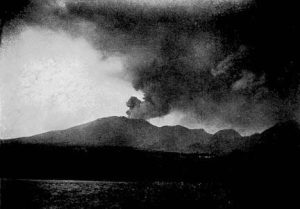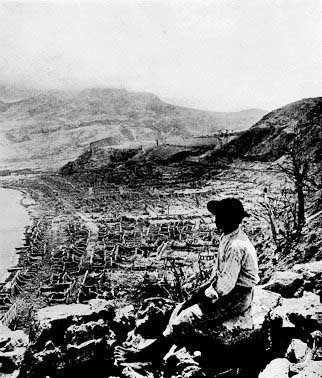
Photo: Angelo Heilprin, American geologist (1853-1907)
Public Domain via Wikimedia Commons
On the lovely Caribbean island of Martinique, Mount Pelee erupted at 7:50 a.m. on 8 May 1902 killing 30,000 people most who were in the city of Saint-Pierre. Concern over the volcano had been growing due to is recent activity. In April explosions had begun at its summit. Numerous quakes, ash showers, and thick clouds of sulfurous gas affected the entire region. This caused many ground insects and snakes to come into Saint-Pierre causing serious problems for everyone and livestock. 50 people died from snakebites mostly children. As volcanic activity continued, water sources became contaminated with ash resulting in livestock dying. Outdoor activities near the mountain were cancelled and by May many were worried.
On 5 May, a crater gave way sending a torrent of scalding water and pyroclastic debris into a river and burying workers at a sugar works. The lahar (the name for such flows) was traveling 62 mph (100 kph)when it hit the sea causing a small tsunami to flood the low lying areas of Saint-Pierre. By 7 May things were getting worse with more ash clouds and glows of reddish-orange being seen from the craters at night.
Many began fleeing into the city (it was believed safe from lava flows)while many were trying to flee. Those that did leave would realize later how lucky they were.

Public Domain via Wikimedia Commons
A large black cloud composed of superheated gas, ash and rock rolled headlong down the south flank of Mt. Pelée at more than 100 miles per hour, its path directed by the V-shaped notch at the summit. In less than one minute it struck St. Pierre with hurricane force. The blast was powerful enough to carry a three-ton statue sixteen meters from its mount. One-meter-thick masonary walls were blown into rubble and support girders were mangled into twisted strands of metal. The searing heat of the cloud ignited huge bonfires. Thousands of barrels of rum stored in the city’s warehouses exploded, sending rivers of the flaming liquid through the streets and into the sea. The cloud continued to advanced over the harbor where it destroyed at least twenty ships anchored offshore. The hurricane force of the blast capsized the steamship Grappler, and its scorching heat set ablaze the American sailing ship Roraima, killing most of her passengers and crew. The Roraima had the misfortune of arriving only a few hours before the eruption. Those on on board could only watch in horror as the cloud descended on them after annihilating the city of St. Pierre. Of the 28,000 people in St. Pierre, there were only two known survivors.
(How Volcanoes Work: MT. PELÉE ERUPTION (1902),Geology Department,University of San Diego)

Public Domain
It was the largest loss of life due to a volcano in the 20th century. And the only volcano in French history to cause loss of life (Martinique is a department of France). The city of Saint-Pierre was no more. The French warship Suchet found mostly ruins and corpses. Anything in the direct path of the pyroclastic flow was destroyed completely (about 8 square miles). Outside of that zone the damage was less and more people survived. Another eruption on 20 May would obliterate what was left of Saint-Pierre killing 2,000 most of whom were rescuers, engineers and mariners. On 30 Aug another eruption occurred causing more fatalities and a tsunami. It was the last fatal eruption of Mount Pelee. It would erupt again in 1929 but authorities evacuated so no lives were lost.
The city of Saint-Pierre was never rebuilt and small villages now exists where it once did. Mount Pelee has been quiet but is under constant watch and considered an active volcano.
Sources
Devastating Disasters. devastatingdisasters.com/mount-pelee-volcanic-eruption-may-8-1902.
—. “Mount Pelée Begins to Erupt, Burying Caribbean City.” HISTORY, 6 May 2024, www.history.com/this-day-in-history/volcanic-eruption-buries-caribbean-city.
“The Eruption of La Montagne Pelée.” History Today, www.historytoday.com/archive/months-past/eruption-la-montagne-pelee.
—. “1902 Eruption of Mount Pelée.” Wikipedia, 6 May 2024, en.wikipedia.org/wiki/1902_eruption_of_Mount_Pel%C3%A9e.


